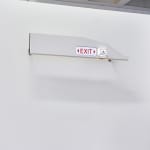Ju Young Kim
Extra legroom on an exit row, 2024
Exit sign on aircraft, stained glass, steel and LED
24 x 120 x 7 cm
9 1/2 x 47 1/4 x 2 3/4 inches
9 1/2 x 47 1/4 x 2 3/4 inches
Copyright The Artist
Photo: Marjorie Brunet Plaza
'Extra legroom on an exit row' (2024) ist Teil der Werkserie AEROPLASTICS, in der Ju Young Kim Übergangszustände und Transitzonen untersucht, indem sie industrielle Transportmodule aus Flugzeugen zu symbolisch verschlüsselten...
"Extra legroom on an exit row" (2024) ist Teil der Werkserie AEROPLASTICS, in der Ju Young Kim Übergangszustände und Transitzonen untersucht, indem sie industrielle Transportmodule aus Flugzeugen zu symbolisch verschlüsselten Werken transformiert. Sie kombiniert diese mit Glasmalerei, Metallgüssen, sowie Keramik und Kunststoff und verbindet somit High-Tech Objekte mit handwerklichen Techniken. Dabei greift die Künstlerin immer wieder auf Jugendstilelemente zurück, deren florale Formensprache Anfang des 20. Jahrhunderts dem Ziel folgte, die Natur in die moderne Welt und die beginnende Industrialisierung zu integrieren. Ihrem ursprünglichen Kontext entnommen, wirken diese Elemente in Kims Werken auf surreale Weise, zwischen unterschiedlichen Zeithorizonten bewegend und einen neuen Blick auf die Phänomene einer globalisierten Welt eröffnend. Dabei untersucht Kim die Relativität von Raum und Zeit aus der Perspektive einer Transkontinentalreisenden. So treffen landschaftliche Motive und traditionelle Symbolik auf Industrieprodukte und Transportsysteme, um das Bild einer beschleunigten Gesellschaft zu zeichnen, in der verschiedene kulturelle und zeitliche Komponenten aufeinandertreffen. Die Künstlerin untersucht Gefühle der parallelen Existenz und der Instabilität, die durch das Leben an unterschiedlichen Orten entstehen, und erkundet Konzepte von Identität, Zugehörigkeit und Heimat.
"Extra legroom on an exit row" verweist auf die architektonische Konstruktion des Transportmittels und die Sitzplätze, die sich direkt am Notausgang befinden und mit zusätzlichem Komfort angeboten werden. Gleichzeitig deutet das leuchtende Signalschild auf die Geschlossenheit des Raums während des Fluges hin und den kapselartigen Transitzustand, indem sich das Verhältnis von Raum und Zeit verschiebt.
"Extra legroom on an exit row" (2024) is part of the work series AEROPLASTICS, in which Ju Young Kim explores liminal states and transit zones by reshaping industrial transportation modules from airplanes into symbolically encoded works. She combines these with stained glass, cast metal, ceramics and plastic, thus combining high-tech objects with artisanal techniques. In doing so, the artist repeatedly draws on Art Nouveau elements, whose floral formal language at the beginning of the 20th century pursued the goal of integrating nature into the modern world and the onset of industrialization. Taken from their original context, these elements appear in Kim's works in a surreal way, moving between different time horizons and opening up a new perspective on the phenomena of a globalized world. Kim examines the relativity of space and time from the perspective of a transcontinental traveler. Landscape motifs and traditional symbolism meet industrial products and transportation systems to paint a picture of an accelerated society in which different cultural and temporal components collide. The artist examines feelings of parallel existence and instability that arise from living in different places and explores concepts of identity, belonging and home.
"In In case of emergency break glass" (2024), Kim transforms part of an airplane wall with a window into a surreal Art Nouveau element reminiscent of a balcony balustrade. In floral ornamentation, the glass references the natural environment, which contrasts with the high-tech means of transportation. At the time, artists sought inspiration for the development of Art Nouveau in nature in order to bring it closer to people at the time of industrialization, which was characterized by technical developments and increasing consumerism. By drawing on historical stylistic elements, Kim refers to parallels in today's society and that of the past, in which technological innovations fundamentally changed the relationship between people and their environment.
"Extra legroom on an exit row" verweist auf die architektonische Konstruktion des Transportmittels und die Sitzplätze, die sich direkt am Notausgang befinden und mit zusätzlichem Komfort angeboten werden. Gleichzeitig deutet das leuchtende Signalschild auf die Geschlossenheit des Raums während des Fluges hin und den kapselartigen Transitzustand, indem sich das Verhältnis von Raum und Zeit verschiebt.
"Extra legroom on an exit row" (2024) is part of the work series AEROPLASTICS, in which Ju Young Kim explores liminal states and transit zones by reshaping industrial transportation modules from airplanes into symbolically encoded works. She combines these with stained glass, cast metal, ceramics and plastic, thus combining high-tech objects with artisanal techniques. In doing so, the artist repeatedly draws on Art Nouveau elements, whose floral formal language at the beginning of the 20th century pursued the goal of integrating nature into the modern world and the onset of industrialization. Taken from their original context, these elements appear in Kim's works in a surreal way, moving between different time horizons and opening up a new perspective on the phenomena of a globalized world. Kim examines the relativity of space and time from the perspective of a transcontinental traveler. Landscape motifs and traditional symbolism meet industrial products and transportation systems to paint a picture of an accelerated society in which different cultural and temporal components collide. The artist examines feelings of parallel existence and instability that arise from living in different places and explores concepts of identity, belonging and home.
"In In case of emergency break glass" (2024), Kim transforms part of an airplane wall with a window into a surreal Art Nouveau element reminiscent of a balcony balustrade. In floral ornamentation, the glass references the natural environment, which contrasts with the high-tech means of transportation. At the time, artists sought inspiration for the development of Art Nouveau in nature in order to bring it closer to people at the time of industrialization, which was characterized by technical developments and increasing consumerism. By drawing on historical stylistic elements, Kim refers to parallels in today's society and that of the past, in which technological innovations fundamentally changed the relationship between people and their environment.



